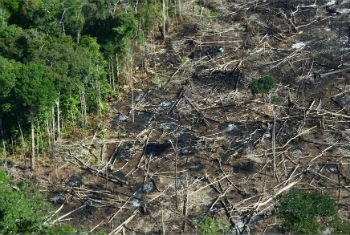Deforestation or deforestation refers to the total or partial elimination of any type of vegetation cover. Currently, it is considered one of the biggest environmental problems.
 Deforestation of the Amazon Forest
Deforestation of the Amazon Forest
Deforestation in Brazil
In Brazil, there was an advance in deforestation with the arrival of the Portuguese in 1500, who exploited brazilwood for sale in Europe.
However, with the Industrial Revolution of the 18th century, global deforestation reached an unprecedented acceleration.
Brazil, like other tropical countries, suffers from high rates of deforestation. Among the causes of deforestation, the following stand out:
- Agricultural and livestock activities, responsible for 80% of global deforestation;
- Urbanization;
- Commercial timber exploitation, mainly hardwood.
It is estimated that since 1970, Brazil has lost 18% of its forests to deforestation. In size, this value is equivalent to the territory of the states of Rio Grande do Sul, Santa Catarina, Paraná, Rio de Janeiro and Espírito Santo.
Although some years have shown a reduction in deforestation rates, it is known that it has increased over time throughout Brazil.
Learn more about deforestation in Brazil.
Deforestation in the Amazon
Deforestation is the human activity that most affects the Amazon. The deforested area is already larger than the territory of France.
To give an example of the threat of deforestation to the conservation of the Amazon, in 2001, deforested areas comprised 11% of the Amazon rainforest Brazilian.
Almost 80% of the Amazon's deforested areas have become passageways or regenerating forests.
Between 2015 and 2016, deforestation in the Amazon reached 7,989 km2, according to the National Institute for Space Research (INPE). This value represents an increase of about 30% compared to that registered between 2014 and 2015.
O deforestation arc is the region of 500 thousand km2 where deforestation is concentrated in the Amazon. It comprises the extreme east and south of the region, in the states of Rondônia, Acre, Mato Grosso and Pará.
In this region, agricultural activity, especially soy production, moves into the forest and compromises its conservation.
To contain deforestation in the Amazon, in 2004, the Action Plan for the Prevention and Control of Deforestation in the Legal Amazon was created.
The region is also monitored by satellites so that deforested areas can be registered and those responsible for the action can be punished.
See too: Deforestation in the Amazon
Deforestation in the Atlantic Forest
THE Atlantic forest represents the first Brazilian biome to be deforested. The devastation of the forest started even at the time of colonization with the exploitation of pau-brasil.
Currently, less than 12% of its original vegetation cover remains.
In the period from 2015 to 2016, studies indicate a deforestation of 290 km2, in the Atlantic Forest, which represents an increase of 57.7% in relation to the previous period. Bahia was the state that deforested the most.
Deforestation in the Cerrado
The agricultural activity is the main responsible for the deforestation of the thick. As in other Brazilian biomes, its deforestation rates are also increasing.
The Cerrado lost 9,483 km2 of vegetation in the year 2015. This value is higher than the Amazon deforestation in the same year.
It is estimated that there are only 20% of its original vegetation. Some projections indicate that if the devastation of the area is not controlled, the Cerrado could disappear by 2030.
Read too:
- Brazilian Biomes
- Tropical forest
- Environmental impacts
What are the consequences of deforestation?
Deforestation has a series of consequences that are not limited only to the natural environment, but also to the lives of human beings.
Forests prevent soil erosion and desertification, recycle carbon dioxide and help to harmonize climate, especially in terms of rainfall.
The main consequences of deforestation are:
- Lost of biodiversity;
- Soil exposure to erosion;
- Loss of environmental services;
- desertification;
- Global warming;
- Contribution to intensifying the greenhouse effect, as deforestation releases significant amounts of greenhouse gases.
And what are its causes?
Deforestation may have a natural cause, however, human activity is the main responsible for the process.
The causes of deforestation are varied, but range from the need for forest products (wood, medicines, fruits, fibers, hunting, etc) to the expansion of cities.
A fact is that human beings have been destroying these areas since prehistoric times to meet their needs.
One of the ways to carry out deforestation is through burned.
Deforestation in the world
Developed countries were the first to destroy their forests for economic gains. Thus, a good part of the vegetated areas of the countries considered richer are totally destroyed.
Currently, developing countries are the main responsible for deforestation in the world.
What are the most deforested areas in the world?
- Forests of Indo-Burma (Asia-Pacific);
- New Zealand (Oceania);
- Sunda (Indonesia, Malaysia and Brunei-Asia-Pacific);
- Philippines (Asia-Pacific);
- Atlantic Forest (South America);
- Mountains of South-Central China (Asia);
- California Floristic Province (North America);
- Coastal Forests of East Africa (Africa);
- Madagascar and Indian Ocean Islands (Africa);
- Forests of Afromontane (East Africa).
Read too:
- Enem geography: subjects that fall the most
- Environmental problems
- Sustainable development
